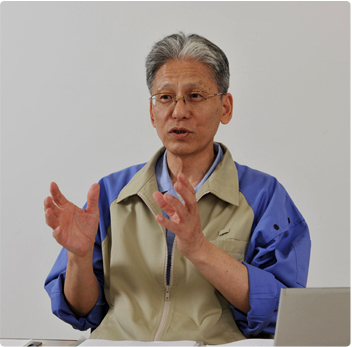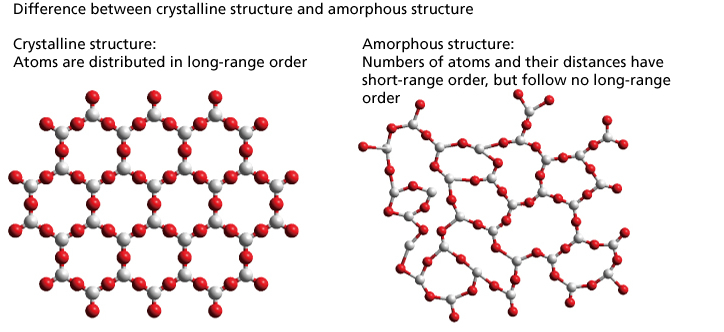The attractions of glass and thin film.
What is an optical thin film?

What are the characteristics of glass?
First of all, let me tell you about the basic structure of glass. Different from crystal, which has periodic atomic structure, glass has an irregular, amorphous structure. While atoms are distributed regularly in crystalline structures, amorphous structures consist of irregular patterns of atoms. This is the main characteristic of glasses. This difference in their structure causes differences in their functions. Crystal reacts sensitively to the introduction of impurities, changing its transparency and electrical properties. However, glass is less sensitive and doesn't easily change its properties. Glass, like liquid, can be uniformly mixed with different substances. With that said, glass is a convenient material because it can be given another function while maintaining its original functions.

Could you give us a concrete example?
Laser glass and scintillator glass are a couple of examples. Another is the glass used in radiation-shielding windows, which includes lead oxide in its composition to block radiation such as gamma rays. When radiation hits the window, the color of the glass changes, deteriorating the transmittance. In order to prevent this, cerium oxide is also dispersed in the glass. While controlling its color with the foreign substance of cerium oxide, we are maintaining the original transparency and functions of the glass; this is the uniqueness of glass, as I mentioned previously.
We can also add a light control function by applying a thin coating of certain materials, not within the glass, but on the surface. This is known as a thin film.
What is a thin film?
Familiar examples of a thin film are the oil films formed on a water surface or soap bubbles, on which you can see interference colors. The thin film I dealt with was an optical thin film, which forms on a glass surface. The thin film's interference controls the light transmission characteristics of a certain wavelength and controls the polarization properties of light*1. Layering such thin films, we can add a variety of functions to the glass. As many as 100 or 200 films, each of them 50 to 100nm*2 thin, can be layered. When undertaking the development of thin films, a complete understanding of the thin film materials and precisely controlling the depositional process are crucial.
What are the future possibilities of glass?
We develop a functional glass or an optical thin film as a technology to bend and direct light to wherever it is required or to change its function. As long as there is light, the pursuit for such technologies will never end. Controlling light by using such media as glasses and thin film layering will continue to have a wide range of uses and has much potential for the future.
- *1Polarized light: Electromagnetic wave, or light, that oscillates in a certain direction
- *2nm: One nanometer equals 1/1,000,000 millimeter
After joining Nikon, I learned about glass.
What did you learn in college, and how did you join Nikon?
In my college days, I belonged to the physics department where I studied the changes of physical properties at ultralow temperatures. I also experimented with the evaluation of the characteristics of semiconductors at ultralow temperatures and did research on superconductivity. Back then, it was a tough time for new graduates to find a job. Many companies cut down the number of entry-level positions in the wake of the 1973 oil crisis. Counter to that economic situation, I guess, Nikon hired about 100 new graduates. Thanks to that, I joined Nikon.
Did you learn about glass after you joined Nikon?
Yes. Nikon is one of the very few optical companies that undertake all the manufacturing processes from melting glass to manufacturing optical machine parts, which I didn't know until I joined the company. I was surprised when I was first assigned to the glass manufacturing division. I spent the first year studying glass. Every week, I translated English documents about glass into Japanese and had them checked by my boss. That was my homework each weekend. It was rigorous training. By the way, the submanager, my boss at that time, was Nikon's former chairman, Michio Kariya. Although in some way I resented a situation where I had to study very hard even after college, it allowed me to acquire the solid basics of a knowledge of glass.
Were you able to apply anything you learned in college to the job at Nikon?
I don't recall any occasion when the learning and experience from my school days directly helped my work at Nikon. But I had read many books during my college years. Although I didn't completely finish many of them, it helped me after I started my career here, because I knew which book to refer to when I faced obstacles.
